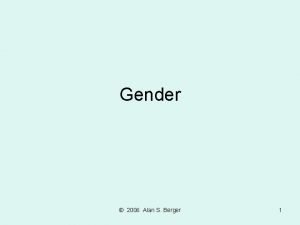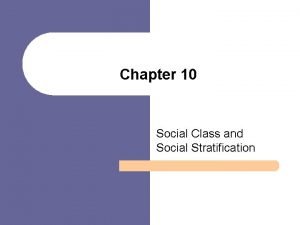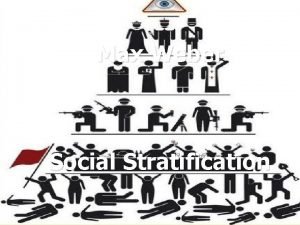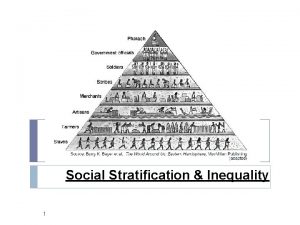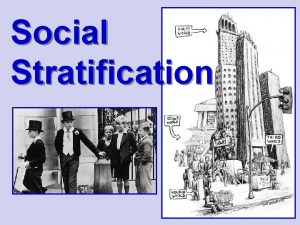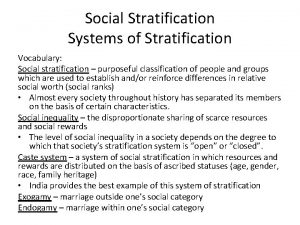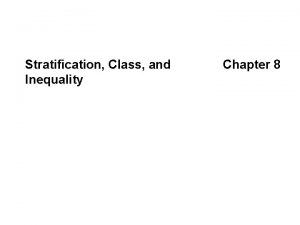Social Stratification and Inequality Social stratification The ranking





















- Slides: 21

Social Stratification and Inequality

Social stratification = The ranking of people in a society into a hierarchy based on class, gender, ethnicity and/or age In a stratified society, there is an unequal distribution of things that are perceived as valuable (e. g. in North America, people who upper class are more likely to have a better education, live in larger homes, own more goods, etc. than those in the middle or lower classes)

Morumbi Slums, Sao Paulo, Brazil

Caracas, Venezuela. The shacks on the left are called “ranchos” and are home to over 80% of the population of Caracas.

Buenos Aires, Argentina

Systems of Social Stratification Closed systems: allow for little change in social position (e. g. slavery; caste system) Open systems: permit a lot of flexibility (e. g. class system)

Slavery Most extreme form of social stratification A closed system people are owned by others and are treated as property Slaves have little control over their lives

Throughout time, people have been enslaved for a variety of reasons: to pay off debts, as punishment for crime, as prisoners of war, or because of social status at birth

Example: Atlantic Slave Trade Africans were captured and sold by African slave dealers to European traders Transported to colonies in N. and S. America Forced to labour on plantations; in mines; in rice fields; in the construction, timber and shipping industries; or in houses as servants Ended in 19 th century, but legacy of blacks being subservient to whites continues to influence relationships between those groups


Indigenous African slavers from coastal regions would travel far into the interior to obtain slaves. They were generally better armed, having obtained guns from European merchants in trade for slaves. Slaves are yoked with a forked branch and fixed in place with an iron pin across the back of their necks. The slightest tug on the branch could choke the prisoner.

From an engraving entitled An Englishman Tastes the Sweat of an African, numbered from right to left the image shows Africans displayed for sale in a public market, an African being examined before purchase, an Englishman licking sweat from the African's chin to test whether he is sick with a tropical disease (a sick slave would quickly infect the rest of the 'human cargo' on a tightly packed slave ship), and an African slave wearing an iron slave marker.

Prisoners could be held in slave sheds, or barracoons, for several months whilst awaiting the arrival of European merchants. Slaves are shown hobbled to roughly hewn logs (on left) or in stocks (on right). Slaves would be fastened to the roof supports by rope, attached around their necks or interweaved into their hair.

The Europeans built several castles and forts, along the coast of West Africa – Elmina, Cape Coast, etc. . These fortresses, otherwise known as 'factories', were the first permanent trading stations built by Europeans in Africa.

A detailed drawing of the slave ship Brookes, showing how 482 people were to be packed onto the decks. The detailed plans and cross sectional drawing of the slave ship Brookes was distributed by the Abolitionist Society in England as part of their campaign against the slave trade, and dates from 1789.






 Social stratification vs social inequality
Social stratification vs social inequality Sociopoly
Sociopoly Seo meetup
Seo meetup Lesson 1-6 solving compound and absolute value inequalities
Lesson 1-6 solving compound and absolute value inequalities Social stratification of gender
Social stratification of gender Mixed social stratification
Mixed social stratification Regular expression symbols
Regular expression symbols Max weber class
Max weber class Social stratification in sociology
Social stratification in sociology Chapter 8 social stratification
Chapter 8 social stratification Social stratification dimensions
Social stratification dimensions Stratification weber
Stratification weber Max weber social class
Max weber social class Systems of social stratification
Systems of social stratification Ideology examples
Ideology examples Stratifikasi sosial berdasarkan kriteria sosial
Stratifikasi sosial berdasarkan kriteria sosial Mixed social stratification
Mixed social stratification Chapter 9 social stratification
Chapter 9 social stratification Chapter 8 social stratification
Chapter 8 social stratification Status weber
Status weber Global stratification systems
Global stratification systems Inequality social class
Inequality social class




